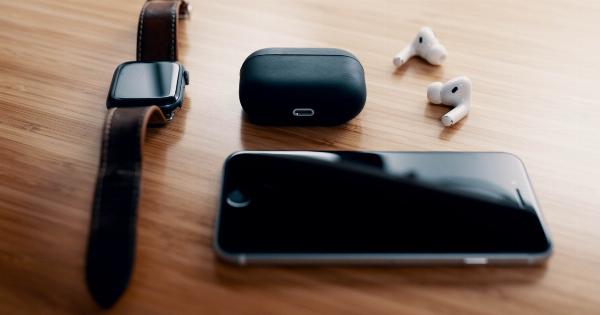Over the years, technology has revolutionized the healthcare industry by bringing innumerable advancements in diagnostics and treatment. One such breakthrough is the development of handheld cancer detectors integrated with mobile technology.
These portable devices have significantly enhanced cancer detection capabilities, enabling early diagnosis and improved patient outcomes.
How Handheld Cancer Detectors Work
Handheld cancer detectors are compact devices equipped with cutting-edge sensors and advanced algorithms. They utilize various technologies such as spectroscopy, imaging, and biomarker analysis to detect and analyze cancerous cells or tumors.
These detectors can be connected to mobile devices, such as smartphones or tablets, which serve as a user interface and provide real-time results.
Benefits of Handheld Cancer Detectors
The integration of mobile technology with cancer detectors offers several advantages:.
1. Early Detection:
Early detection plays a crucial role in improving cancer survival rates. Handheld detectors enable early diagnosis by detecting cancer at its early stages when it is most treatable.
2. Portability:
Unlike traditional diagnostic equipment, handheld detectors are compact and portable, allowing healthcare professionals to perform diagnostic tests anywhere, even in remote or underserved areas.
3. Cost-Effectiveness:
Handheld cancer detectors are typically more affordable than specialized diagnostic equipment. This affordability makes cancer screening more accessible to a larger population, especially in resource-limited settings.
4. Convenience:
The integration with mobile technology offers convenience and ease of use. The detectors can be easily connected to smartphones or tablets, enabling healthcare professionals to perform tests with minimal training.
5. Real-Time Results:
With mobile integration, the detectors provide real-time analysis and instant results. This allows for immediate decision-making and timely intervention, leading to better patient management.
6. Patient Empowerment:
Handheld cancer detectors break the barrier between healthcare professionals and patients, allowing individuals to monitor their own health. Patients can use these devices for regular self-checks, promoting early detection and proactive healthcare.
Applications of Handheld Cancer Detectors
The integration of mobile technology has expanded the applications of handheld cancer detectors, benefiting both healthcare professionals and patients:.
1. Breast Cancer Screening:
Handheld detectors can be used for regular breast self-examination, aiding in the early detection of breast cancer.
The integration with mobile technology provides a user-friendly interface for performing self-checks and monitoring any changes in breast tissue.
2. Skin Cancer Detection:
These detectors equipped with imaging capabilities can help identify suspicious moles or lesions on the skin.
Users can capture images using their mobile devices, and the integrated algorithms can analyze the images to determine the probability of skin cancer.
3. Oral Cancer Screening:
Handheld cancer detectors integrated with mobile technology can assist in oral cancer screening.
Users can take pictures of their oral cavity, and the device’s algorithms can analyze the images to identify any abnormalities or potential signs of oral cancer.
4. Cervical Cancer Screening:
Through specialized attachments, handheld detectors can be used for cervical cancer screening. These attachments capture images of the cervix, and the integrated algorithms analyze them, detecting any signs of pre-cancerous or cancerous lesions.
5. Blood Cancer Detection:
Handheld cancer detectors can analyze blood samples, identifying specific biomarkers associated with blood cancers such as leukemia or lymphoma. This non-invasive method facilitates early detection and monitoring of these cancer types.
6. Lung Cancer Detection:
By utilizing breath analysis technology, handheld detectors can detect volatile organic compounds (VOCs) in a person’s breath, which can serve as indicators of lung cancer.
The integration with mobile technology provides a user-friendly platform for conducting these tests.
The Future of Handheld Cancer Detectors
The integration of handheld cancer detectors with mobile technology is continuously evolving, with ongoing research and development to enhance their capabilities:.
1. Artificial Intelligence:
Integrating artificial intelligence (AI) algorithms into handheld cancer detectors can improve accuracy and efficiency in cancer detection.
AI can analyze vast amounts of data and patterns, assisting healthcare professionals in making more informed diagnostic decisions.
2. Wireless Connectivity:
Future handheld detectors may incorporate wireless connectivity features, allowing seamless transmission of data to healthcare facilities.
This enables healthcare professionals to remotely monitor patients’ test results and provide immediate guidance or intervention if required.
3. Remote Diagnostics:
The integration of telemedicine capabilities with handheld cancer detectors can facilitate remote diagnostics.
Patients can perform tests at home and securely transmit the results to healthcare professionals, leading to improved access to healthcare services.
4. Multi-Cancer Screening:
Ongoing advancements aim to develop handheld detectors capable of screening for multiple types of cancer simultaneously. This would enable comprehensive cancer screening and early detection of various cancer types using a single device.
5. Enhanced Data Analytics:
Improved data analytics algorithms can help healthcare professionals interpret and utilize the vast amount of data collected by handheld detectors. These advancements can aid in personalized treatment strategies and predictive analytics.
Conclusion
Handheld cancer detectors integrated with mobile technology have revolutionized cancer detection and screening. Their portable nature, affordability, and real-time results have made them invaluable tools in the fight against cancer.
As technology continues to advance, these devices will play an even more significant role in early diagnosis, remote monitoring, and personalized treatment of various types of cancer.



























